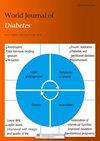建立 2 型糖尿病患者牙周炎影响因素预测模型
IF 4.2
3区 医学
Q1 ENDOCRINOLOGY & METABOLISM
引用次数: 0
摘要
背景 2 型糖尿病(T2DM)与牙周炎有关。目前,很少有研究提出 T2DM 患者牙周炎的预测模型。目的 通过构建逻辑回归和随机森林模型,确定影响 T2DM 患者牙周炎的因素。方法 在这项回顾性研究中,我们选取了 2022 年 1 月至 2022 年 6 月期间在温岭市第一人民医院住院治疗的 300 名 T2DM 患者作为研究对象,并从住院病历中收集了他们的数据。采用逻辑回归分析 T2DM 患者牙周炎的相关因素,建立随机森林预测模型和逻辑回归预测模型。使用接收者操作特征曲线下面积(AUC)比较了模型的预测效率。结果 在 300 名 T2DM 患者中,224 人患有牙周炎,发生率为 74.67%。800)、糖化血红蛋白(HbA1c)(OR = 2.545,95%CI:1.770-3.661)、总胆固醇(TC)(OR = 2.872,95%CI:1.725-4.781)和甘油三酯(TG)(OR = 3.306,95%CI:1.019-10.723)影响牙周炎的发生(P < 0.05)。随机森林模型显示,影响最大的变量是 HbA1c,其次是年龄、TC、TG、教育程度、刷牙频率和性别。两种模型预测效果的比较显示,在训练数据集中,随机森林模型的AUC高于逻辑回归模型(AUC = 1.000 vs AUC = 0.851;P < 0.05)。在验证数据集中,随机森林模型和逻辑回归模型的 AUC 没有显著差异(AUC = 0.946 vs AUC = 0.915;P > 0.05)。结论 随机森林模型和逻辑回归模型都具有良好的预测价值,可以准确预测 T2DM 患者患牙周炎的风险。本文章由计算机程序翻译,如有差异,请以英文原文为准。
Establishment of models to predict factors influencing periodontitis in patients with type 2 diabetes mellitus
BACKGROUND
Type 2 diabetes mellitus (T2DM) is associated with periodontitis. Currently, there are few studies proposing predictive models for periodontitis in patients with T2DM.
AIM
To determine the factors influencing periodontitis in patients with T2DM by constructing logistic regression and random forest models.
METHODS
In this a retrospective study, 300 patients with T2DM who were hospitalized at the First People’s Hospital of Wenling from January 2022 to June 2022 were selected for inclusion, and their data were collected from hospital records. We used logistic regression to analyze factors associated with periodontitis in patients with T2DM, and random forest and logistic regression prediction models were established. The prediction efficiency of the models was compared using the area under the receiver operating characteristic curve (AUC).
RESULTS
Of 300 patients with T2DM, 224 had periodontitis, with an incidence of 74.67%. Logistic regression analysis showed that age [odds ratio (OR) = 1.047, 95% confidence interval (CI): 1.017-1.078], teeth brushing frequency (OR = 4.303, 95%CI: 2.154-8.599), education level (OR = 0.528, 95%CI: 0.348-0.800), glycosylated hemoglobin (HbA1c) (OR = 2.545, 95%CI: 1.770-3.661), total cholesterol (TC) (OR = 2.872, 95%CI: 1.725-4.781), and triglyceride (TG) (OR = 3.306, 95%CI: 1.019-10.723) influenced the occurrence of periodontitis (P < 0.05). The random forest model showed that the most influential variable was HbA1c followed by age, TC, TG, education level, brushing frequency, and sex. Comparison of the prediction effects of the two models showed that in the training dataset, the AUC of the random forest model was higher than that of the logistic regression model (AUC = 1.000 vs AUC = 0.851; P < 0.05). In the validation dataset, there was no significant difference in AUC between the random forest and logistic regression models (AUC = 0.946 vs AUC = 0.915; P > 0.05).
CONCLUSION
Both random forest and logistic regression models have good predictive value and can accurately predict the risk of periodontitis in patients with T2DM.
求助全文
通过发布文献求助,成功后即可免费获取论文全文。
去求助
来源期刊

World Journal of Diabetes
ENDOCRINOLOGY & METABOLISM-
自引率
2.40%
发文量
909
期刊介绍:
The WJD is a high-quality, peer reviewed, open-access journal. The primary task of WJD is to rapidly publish high-quality original articles, reviews, editorials, and case reports in the field of diabetes. In order to promote productive academic communication, the peer review process for the WJD is transparent; to this end, all published manuscripts are accompanied by the anonymized reviewers’ comments as well as the authors’ responses. The primary aims of the WJD are to improve diagnostic, therapeutic and preventive modalities and the skills of clinicians and to guide clinical practice in diabetes. Scope: Diabetes Complications, Experimental Diabetes Mellitus, Type 1 Diabetes Mellitus, Type 2 Diabetes Mellitus, Diabetes, Gestational, Diabetic Angiopathies, Diabetic Cardiomyopathies, Diabetic Coma, Diabetic Ketoacidosis, Diabetic Nephropathies, Diabetic Neuropathies, Donohue Syndrome, Fetal Macrosomia, and Prediabetic State.
 求助内容:
求助内容: 应助结果提醒方式:
应助结果提醒方式:


